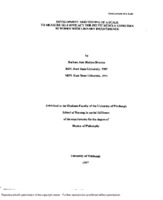Development and testing of a scale to measure self-efficacy for pelvic muscle exercises in women with urinary incontinence
View File(s)
Visitor Statistics
Visits vs Downloads
Visitors - World Map
Top Visiting Countries
| Country | Visits |
|---|
Top Visiting Cities
| City | Visits |
|---|
Visits (last 6 months)
Downloads (last 6 months)
Popular Works for Broome, Barbara S. by View
| Title | Page Views |
|---|
Popular Works for Broome, Barbara S. by Download
| Title | Downloads |
|---|
View Citations
Citations
Previous research has demonstrated that behavioral interventions utilizing pelvic muscles can reduce or eliminate incontinence for many individuals. Active patient participation is a key component for all behavioral interventions; thus, a person's self-efficacy, the belief in one's ability to successfully participate in a behavior and one's belief that the behavior will produce a specified outcome, is an important ingredient to successful outcomes. Behavior specific measures of self-efficacy provide information about individual perceptions of a specific ability. To date, only one scale has been located that was developed to measure self-efficacy for pelvic muscle exercises in women with urinary incontinence, however psychometrics for the scale were not reported (Svengalis, Nygaard, Cervone & Kreder, 1995). The purpose of this methodological study was to: (1) develop a scale that can be used to measure perceived self-efficacy for pelvic muscle exercises; and, (2) test the scale for reliability and validity in a group of women with incontinence. The 23 item scale incorporated items from self-efficacy expectation and outcome expectation, the two domains of self-efficacy theory as they relate to urinary incontinence. Psychometric analysis of reliability and validity was determined from data collected from a sample of 115 cognitively intact incontinent women recruited from community and religious groups in Northeastern Ohio. The estimated internal consistency reliability of the Broome PMSES using Cronbach's alpha was.97 and test retest 14 days later was.72. Validity was examined by correlating the Broome PMSES with the depression and quality of life measures. The correlation, although modest for the depression (r = $-$.25, p $<$.01) and quality of life measures (r = $-$.36, p $<$.01) was in the anticipated direction. An additional clinic sample of 20 women treated for incontinence was recruited from continence treatment programs. In this sample, those women who reported fewer UI accidents after treatment had a significantly (p =.012) higher mean self-efficacy score at baseline than those who reported no reduction in accidents. The preliminary data from this study provides a foundation which can be used to modify the instrument and to examine reliability and validity in other populations with urinary incontinence.
This dissertation has also been disseminated through the ProQuest Dissertations and Theses database. Dissertation/thesis number: 9816849; ProQuest document ID: 304369546. The author still retains copyright.
This item has not gone through this repository's peer-review process, but has been accepted by the indicated university or college in partial fulfillment of the requirements for the specified degree.
| Type | Dissertation |
| Acquisition | Proxy-submission |
| Review Type | None: Degree-based Submission |
| Format | Text-based Document |
| Evidence Level | Other |
| Research Approach | Pilot/Exploratory Study |
| Keywords | Pelvic Floor Exercise; Bladder Health; Women with Incontinence |
| CINAHL Subject(s) | Urinary Incontinence; Instrument Construction; Kegel Exercises; Self-Efficacy; Urinary Incontinence--Therapy |
| Grantor | University of Pittsburgh |
| Advisor | McDowell, B. Joan |
| Level | PhD |
| Year | 1997 |
All rights reserved by the author(s) and/or publisher(s) listed in this item record unless relinquished in whole or part by a rights notation or a Creative Commons License present in this item record.
All permission requests should be directed accordingly and not to the Sigma Repository.
All submitting authors or publishers have affirmed that when using material in their work where they do not own copyright, they have obtained permission of the copyright holder prior to submission and the rights holder has been acknowledged as necessary.
Related items
Showing items related by title, author, creator and subjects.
-
Decreasing urinary incontinence in the home health setting
Albertson, Maureen (2017-08-30)BACKGROUND: Urinary incontinence (UI) in the home care population poses a risk for complications and hospitalization. The aim of this project was to develop and implement a protocol for UI to promote continence in the home ... -
The effect of pelvic floor biofeedback training for urinary incontinence in prostate cancer survivors: A meta-analysis of randomized controlled trials
Hsu, Lan-Fang; Tsai, Pei-Shan (2014-11-17)Session presented on Saturday, July 26, 2014: Background: Urinary incontinence (UI) is a distressing problem after radical prostatectomy (RP) and impairs the quality of life of prostate cancer survivors. Pelvic floor ... -
A review of methods for assessing female pubovisceral muscle tear and strength
Sheng, YingThis study reviewed measures of structural integrity and strength of pubovisceral muscle. Pubovisceral muscle is the most vulnerable portion of pelvic muscles to be torn from pubic bone during vaginal births, and related ... -
Development of a scale to measure self-efficacy to respond to disruptive behaviors
Sanner-Stiehr, Ericka J. (2018-03-22)Self-efficacy to respond effectively to disruptive behaviors can be improved through cognitive rehearsal training, requiring a domain-specific instrument to measure intervention effectiveness. This project describes the ... -
Validity and reliability of Thai version of self-efficacy for appropriate medication use scale among Thai with post-myocardial infarction
Polsook, Rapin; Duffy, Joanne R.; Aungsuroch, Yupin; Thanasilp, Sureeporn (2014-11-17)Session presented on Friday, July 25, 2014: Purpose: The purpose of this study was to translate the self-efficacy for appropriate medication use into Thai and then examine the validity and reliability of this version of ...





